 Image search results - "ichinomiya" Image search results - "ichinomiya" |

Ichinomiya Station has both the JR Tokaido Line and Meitetsu Line. Ichinomiya literally means "Shrine No. 1."
|
|
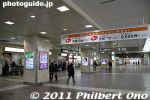
Inside Ichinomiya Station. It's pretty big. There are a few restaurants/shops.
|
|

Rotary
|
|

Way to Honmachi shopping street.
|
|

Honmachi shopping arcade in Ichinomiya.
|
|

Honmachi shopping arcade leads to Masumida Shrine. The banner says Happy New Year.
|
|

Along the way in Honmachi arcade is a branch office of Ichinomiya City Hall with a musical clock.
|
|

Musical clock
|
|

Poster for Masumida Shrine hatsumode New Year's worshipping.
|
|

After you exit Honmachi arcade, you see Masumida Shrine across the street.
|
|
|

Masumida Shrine torii.
|
|

I went to Masumida Shrine on Jan. 1, 2011 in the morning when it was still not that crowded.
|
|

Masumida Shrine torii flanked with kadomatsu bamboo/pine decorations.
|
|

Kadomatsu bamboo/pine decoration on New Year's Day.
|
|
|

Romon Gate built in 1961. 楼門
|
|
|

Barrels of sake rice wine near Romon Gate.
|
|

Next to Romon Gate is this giant ema tablet with a rabbit design. 2011 is the year of the rabbit.
|
|

After passing through Romon Gate, you see this. Straight ahead is the Honden shrine hall where you pray. On the left and right were food booths.
|
|

Masumida Shrine Honden hall 御本殿
|
|

Wash basin to purify yourself.
|
|

Stall selling charms.
|
|
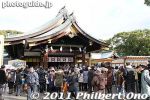
Honden hall. Masumida Shrine worships a deity called Amenoho no Akari no mikoto. 天火明命
|
|

Honden hall
|
|

People pray in front of the Honden where there is a large offertory box.
|
|

Offertory box with money.
|
|
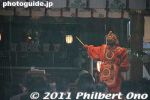
Inside the Honden, special prayers are held for people. Includes a dance.
|
|

More stalls selling charms, etc.
|
|
|

Food stalls
|
|

One unique feature at Masumida Shrine during New Year's is this ring of fire (Hinowa kuguri). 火の輪くぐり
|
|

During Jan. 1-5, for 300 yen, you can enter the ring of fire.
|
|

First you pass through a small torii.
|
|

The ring of fire leads to the Sacred Water Basin.
|
|

Then you walk through the ring of fire which is actually a gas pipe with just a few flames at the top.
|
|
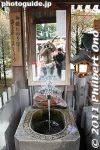
Use the sacred water here to purify yourself.
|
|
|

Look into this well until you see your reflection.
|
|
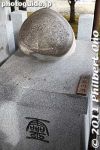
Monument for family harmony.
|
|

At the end, you receive a blessing from a shrine maiden.
|
|

All the sins and impurities stuck onto you will then be shed. Good deal for 300 yen.
|
|
|

Omikuji stall selling fortune paper for 200 yen.
|
|

The omikuji is yellow, and tied onto a fence.
|
|

Another stall selling auspicious charms.
|
|

New Year's is when shrines make the most money selling hopes, dreams, and prayers. Great thing for them is that there is no money-back guarantee that your prayers/dreams will come true.
|
|

Shrine for weaving god. 服織神社
|
|

Praying to the weaving/textile god. After food, clothing is essential for man.
|
|

The monument on the left has a poem written by the 9th daughter of Emperor Meiji.
|
|

Sacred horse
|
|

Place to return your old New Year's decorations and charms.
|
|

Burning the old New Year's and shrine decorations and charms.
|
|

Hot fire fueled by old decorations and charms.
|
|

My video of Masumida Shrine on New Year's Day 2011, Ichinomiya, Aichi.
|
|

Being next to the Pacific Ocean, Chiba has quite a few festivals held on the beach. The Kazusa Junisha Matsuri is one of the larger ones. Sept. 13, 2009 (Sun.) was the main festival day when they went in the water at the beach.
|
|

The day starts with a Shinto ceremony at 10 am at Tamasaki Shrine, near Kazusa-Ichinomiya Station on the JR Sotobo Line. 玉前神社
|
|

Tamasaki Shrine is crowded with people as a ceremony still goes on. The Kazusa Junisha Matsuri started in 807. It is designated as Chiba Prefecture's Intangible Cultural Property.
|
|

Two portable shrines in front of the Kaguraden stage. Kazusa is the name of the former province in central Chiba Prefecture. Junisha means twelve shrines.
|
|

Sacred dance at the Kaguraden by Sarutahiko.
|
|

Tamasaki Shrine torii
|
|

The girls had their hair airbrushed with colorful designs. I've noticed that women and girls participating in matsuri have become quite fashionable, chic, or hip.
|
|

Girls were originally not allowed to participate in the festival, but now they do even though it is a hadaka (nude) festival. Of course, no one is really naked.
|
|

Sacred horse
|
|

One of the child horse riders.
|
|

Child horse rider sits on a bunch of soft cushions on the horse.
|
|
|

A procession departs Tamasaki Shrine at 1 pm, led by Sarutahiko.
|
|

The beginning of the procession consists of a few portable shrines pulled by children.
|
|
|
|

The sacred horse and child riders soon join the procession as they leave Tamasaki Shrine.
|
|

Child rider leaving Tamasaki Shrine.
|
|

Leaving Tamasaki Shrine. It was impossible to judge where I should be to take good shots. I missed quite a few opportunities. I have to see the festival again to take the shots I wanted to take this time.
|
|

Back at Tamasaki Shrine are two other portable shrines which had arrived from Sannomiya Shrine, one of the junisha (12 shrines) in the Kazusa area.
|
|

The portable shrines begin to leave Tamasaki Shrine.
|
|

A portable shrine leaves Tamasaki Shrine.
|
|

They then ran with the portable shrine. They will run while carrying the shrine to the beach several kilometers away.
|
|

The beach is too far to walk, so they provided free shuttle buses to the beach from Kazusa-Ichinomiya Station from 2 pm. It was a 10-15 min. ride to the beach.
|
|

On Kujukuri Beach, there a stretch of beach called Tsurigasaki Kaigan Beach marked by a torii. This will be the Tokyo 2020 Olympic venue for surfing.
|
|

Tsurigasaki Kaigan beach is where they believe the gods arrive. 釣ケ先海岸
|
|

Tsurigasaki Kaigan is where the horses and portable shrines will start to arrive at 2:30 pm to 3 pm. This is where the crowd is. But the beach is big enough for all of us.
|
|

On the beach. Good spot for surfing as well.
|
|

One child horse rider arrives.
|
|

One great thing about this hadaka matsuri is that there are women as well. Most hadaka matsuri have only men.
|
|

The mikoshi arrive on the beach.
|
|
|

They give a few cheers before they started running on the beach.
|
|

Here they come.
|
|

Women too, while they are careful to prevent any nip slips.
|
|

They run on the beach while carrying the mikoshi.
|
|

A stampede.
|
|
|
|

They head for Tsurigasaki Beach, where the torii is.
|
|

They prop up the mikoshi before carrying it toward the ceremony place.
|
|
|
|

The mikoshi start to gather for a ceremony.
|
|

The mikoshi start to gather for a ceremony as they all run at full speed.
|
|
|
|

More mikoshi arrive.
|
|

Shrine priest arrive on horseback. He looked very weary. It was a hot day too.
|
|
|
|

After the ceremony, they head for the water.
|
|

Very jovial and noisy.
|
|

To the beach and water.
|
|

In the water, maybe ankle deep. But the waves made it knee-deep.
|
|
|

Everyone is yelling and cheering.
|
|
|
|
|
|
|
|

They tossed the mikoshi into the air a few times.
|
|
|
|
|
|

Back on land.
|
|
|
|
|
|

Festival girls posing for me. They love the attention.
|
|

Kazusa Junisha Matsuri Festival, Ichinomiya, Chiba on Sept. 13, 2009.
|
|

Women standing by to pull the mikoshi.
|
|
|

Tossing the mikoshi into the air.
|
|

I kept shooting their backs. Next time, I'll try to shoot more faces.
|
|

You could go in front of them to shoot their faces, but the water would be deeper.
|
|

They kept waving their fans and cheering in the water.
|
|
|

Great spectacle, especially with women included. Great idea to allow women in the festival.
|
|
|
|

Returning to land.
|
|

The men covered their bellies, while the women covered their bellies and chests.
|
|

This festival separates the amateur photographers from the pros. Amateurs wear long pants and shoes and enter the ocean to take pictures. I was of course wearing shorts and rubber slippers (but barefoot in the water).
|
|

The next spectacle was them running through the torii on the beach.
|
|

All the mikoshi headed for the torii.
|
|
|

First were the horses galloping through. Each horse was guided by two men running alongside.
|
|

The boy looked thrilled to be riding at full speed. Very bumpy though.
|
|
|

Then the mikoshi sped by one after another.
|
|
|

Love these women running and pulling the mikoshi.
|
|

It's amazing that no one tripped and fell.
|
|

More women in fashionable clothing to pull a mikoshi.
|
|
|

They are cheering and shouting throughout.
|
|
|
|
|
|
|
|
|
|
|
|
|
|
|

It would take them about an hour to get back to town.
|
|

The sacred horse arrive in town.
|
|

More horses arrive.
|
|
|

Making way for the horses.
|
|

Shrine priest arrives.
|
|

From 6 pm, they paraded the mikoshi on the main road near Tamasaki Shrine.
|
|

Like on the beach, they wave fans and cheer.
|
|
|
|

Sometimes they tossed the mikoshi up.
|
|

Women waved fans.
|
|
|
|
|
|
|

From 7 pm, the mikoshi started returning to Tamasaki Shrine. At 8 pm, the god's spirit in the mikoshi was returned to the shrine.
|
|

PR poster for Kazusa Junisha Matsuri.
|
|

Kazusa-Ichinomiya Station on the JR Sotobo Line.
|
|
|
|
|
|